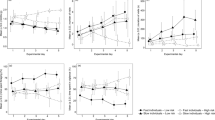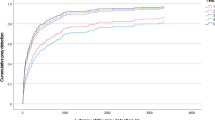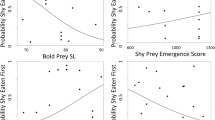Abstract
There is increasing evidence that behavioral flexibility is associated with the ability to adaptively respond to environmental change. Flexibility can be advantageous in some contexts such as exploiting novel resources, but it may come at a cost of accuracy or performance in ecologically relevant tasks, such as foraging. Such trade-offs may, in part, explain why individuals within a species are not equally flexible. Here, we conducted a reversal learning task and predation experiment on a top fish predator, the Northern pike (Esox lucius), to examine individual variation in flexibility and test the hypothesis that an individual’s behavioral flexibility is negatively related with its foraging performance. Pikes were trained to receive a food reward from either a red or blue cup and then the color of the rewarded cup was reversed. We found that pike improved over time in how quickly they oriented to the rewarded cup, but there was a bias toward the color red. Moreover, there was substantial variation among individuals in their ability to overcome this red bias and switch from an unrewarded red cup to the rewarded blue cup, which we interpret as consistent variation among individuals in behavioral flexibility. Furthermore, individual differences in behavioral flexibility were negatively associated with foraging performance on ecologically relevant stickleback prey. Our data indicate that individuals cannot be both behaviorally flexible and efficient predators, suggesting a trade-off between these two traits.





Similar content being viewed by others
References
ABS/ASAB (2003) Guidelines for the treatment of animals in behavioral research and teaching. Anim Behav 65:249–255
Beaudoin CP, Tonn WM, Prepas EE, Wassenaar LI (1999) Individual specialization and trophic adaptability of northern pike (Esox lucius): an isotope and dietary analysis. Oecologia 120:386–396
Becker GC (1983) Fishes of Wisconsin. University of Wisconsin Press, Madison, WI
Becker WC (1992) Manual of quantitative genetics. Academic Enterprises, Pullman, WA
Bélisle C, Cresswell J (1997) The effects of a limited memory capacity on foraging behavior. Theor Popul Biol 52:78–90
Bell AM, Hankison SJ, Laskowski KL (2009) The repeatability of behaviour: a meta-analysis. Anim Behav 77:771–783
Blumroeder J, Eccard JA, Blaum N (2012) Behavioural flexibility in foraging mode of the spotted sand lizard (Pedioplanis l. lineoocellata) seems to buffer negative impacts of savanna degradation. J Arid Environ 77:149–152
Blumstein DT, Daniel JC (2007) Quantifying behavior the JWatcher way. Sinauer, Sunderland, MA
Blumstein DT, Daniel JC, Evans CS (2006) JWatcher 1.0. http://www.jwatcher.ucla.edu/
Bolhuis JE, Schouten WGP, de Leeuw JA, Schrama JW, Wiegant VA (2004) Individual coping characteristics, rearing conditions and behavioural flexibility in pigs. Behav Brain Res 152:351–360
Bolnick DI, Ingram T, Stutz WE, Snowberg LK, Lau OL, Paull JS (2010) Ecological release from interspecific competition leads to decoupled changes in population and individual niche width. Proc R Soc Lond B 277:1789–1797
Bolnick DI, Amarasekare P, Araujo MS, Burger R, Levine JM, Novak M, Rudolf VHW, Schreiber SJ, Urban MC, Vasseur DA (2011) Why intraspecific trait variation matters in community ecology. Trends Ecol Evol 26:183–192
Boogert NJ, Reader SM, Laland KN (2006) The relation between social rank, neophobia and individual learning in starlings. Anim Behav 72:1229–1239
Boogert NJ, Monceau K, Lefebvre L (2010) A field test of behavioural flexibility in Zenaida doves (Zenaida aurita). Behav Process 85:135–141
Bry C (1996) Role of vegetation in the life cycle of pike. Fish Fish 19:45–67
Burns JG, Dyer AG (2008) Diversity of speed-accuracy strategies benefits social insects. Curr Biol 18:R953–R954
Burns JG, Rodd FH (2008) Hastiness, brain size and predation regime affect the performance of wild guppies in a spatial memory task. Anim Behav 76:911–922
Casselman JM (1996) Age, growth and environmental requirements of pike. In: Craig JF (ed) Pike: biology and exploitation. Chapman & Hall, London, pp 69–101
Chittka L, Dyer AG, Bock F, Dornhaus A (2003) Psychophysics — bees trade off foraging speed for accuracy. Nature 424:388
Chittka L, Skorupski P, Raine NE (2009) Speed-accuracy tradeoffs in animal decision making. Trends Ecol Evol 24:400–407
Coppens CM, de Boer SF, Koolhaas JM (2010) Coping styles and behavioural flexibility: towards underlying mechanisms. Philos Trans R Soc B 365:4021–4028
Crossman EJ (1996) Taxonomy and distribution. In: Craig JF (ed) Pike: biology and exploitation. Chapman & Hall, London, pp 1–11
Dally JM, Clayton NS, Emry NJ (2008) Social influences of foraging by rooks (Corvus frugilegus). Behaviour 145:1101–1124
Danisman E, Bshary R, Bergmuller R (2010) Do cleaner fish learn to feed against their preference in a reverse reward contingency task? Anim Cogn 13:41–49
Day LB, Crews D, Wilczynski W (1999) Spatial and reversal learning in congeneric lizards with different foraging strategies. Anim Behav 57:393–407
Giesing ER, Suski CD, Warner RE, Bell AM (2011) Female sticklebacks transfer information via eggs: effects of maternal experience with predators on offspring. Proc R Soc Lond B 278:1753–1759
Hazlett BA (1995) Behavioral plasticity in crustacea: why not more? J Exp Mar Bio Ecol 193:57–66
Healy S (1992) Optimal memory: toward an evolutionary ecology of animal cognition? Trends Ecol Evol 7:399–400
Hughes RN, O’Brien N (2001) Shore crabs are able to transfer learned handling skills to novel prey. Anim Behav 61:711–714
Hurtado-Gonzales JL, Baldassarre DT, Uy JAC (2010) Interaction between female mating preferences and predation may explain the maintenance of rare males in the pentamorphic fish Poecilia parae. J Evol Biol 23:1293–1301
JMP®, version 9.0. SAS Institute Inc., Cary, NC, 1989–2007
Jokela-Maatta M, Smura T, Aaltonen A, Ala-Laurila P, Donner K (2007) Visual pigments of Baltic Sea fishes of marine and limnic origin. Visual Neurosci 24:389–398
Jonasson Z (2005) Meta-analysis of sex differences in rodent models of learning and memory: a review of behavioral and biological data. Neurosci Biobehav R 28:811–825
Jonsson M, Hylander S, Ranaker L, Nilsson PA, Bronmark C (2011) Foraging success of juvenile pike Esox lucius depends on visual conditions and prey pigmentation. J Fish Biol 79:290–297
Koolhaas JM, Korte SM, de Boer SF, van der Vegt BJ, van Reenen CG, Hopster H, de Jong IC, Ruis MAW, Blokhuis HJ (1999) Coping styles in animals: current status in behavior and stress-physiology. Neurosci Biobehav R 23:925–935
Laland KN, Reader SM (1999a) Foraging innovation in the guppy. Anim Behav 57:331–340
Laland KN, Reader SM (1999b) Foraging innovation is inversely related to competitive ability in male but not in female guppies. Behav Ecol 10:270–274
Lefebvre L, Whittle P, Lascaris E, Finkelstein A (1997) Feeding innovations and forebrain size in birds. Anim Behav 53:549–560
Lessells CM, Boag PT (1986) Unrepeatable repeatabilities: a common mistake. Auk 104:116–121
Levin R (1968) Evolution in changing environments. Princeton University Press, Princeton, NJ
MacArthur RH, Levin R (1967) The limiting similarity, convergence, and divergence of coexisting species. Am Nat 101:377–385
McGhee KE, Pintor LM, Surh EL, Bell AM (2012) Maternal exposure to predation risk decreases offspring antipredator behaviour and survival in threespined stickleback. Funct Ecol 26:932–940
McGhee KE, Pintor LM, Bell AM (2013) Reciprocal behavioral plasticity and behavioral types during predator–prey interactions. Am Nat 182:704–717
Milinski M, Lühti JH, Eggler R, Parker GA (1997) Cooperation under predation risk: experiments on costs and benefits. Proc R Soc Lond B 264:1239–1247
Miller AM, Pawlik JR (2013) Do coral reef fish learn to avoid unpalatable prey using visual cues? Anim Behav 85:339–347
Nakagawa S, Schielzeth H (2010) Repeatability for Gaussian and non-Gaussian data: a practical guide for biologists. Biol Rev 85:935–956
Nyqvist MJ, Gozlan RE, Cucherousset J, Britton JR (2012) Behavioural syndrome in a solitary predator is independent of body size and growth rate. PLoS ONE 7:e31619
Olsen VA, Owens IPF (1998) Costly sexual signals: are carotenoids rare, risky or required? Trends Ecol Evol 13:510–514
Overington SE, Griffin AS, Sol D, Lefebvre L (2011) Are innovative species ecological generalists? A test in North American birds. Behav Ecol 22:1286–1293
Page RA, Ryan MJ (2005) Flexibility in assessment of prey cues: frog-eating bats and frog calls. Proc R Soc Lond B 272:841–847
Patankar R, von Hippel FA, Bell MA (2006) Extinction of a weakly armoured threespine stickleback (Gasterosteus aculeatus) population in Prator Lake, Alaska. Ecol Freshw Fish 15:482–487
Pruitt JN, Cote J, Ferrari MCO (2012a) Behavioural trait variants in a habitat-forming species dictate the nature of its interactions with and among heterospecifics. Funct Ecol 26:29–36
Pruitt JN, Stachowicz JJ, Sih A (2012b) Behavioral types of predator and prey jointly determine prey survival: potential implications for the maintenance of within-species behavioral variation. Am Nat 179:217–227
Reader SM, Laland KN (2002) Social intelligence, innovation, and enhanced brain size in primates. Proc Natl Acad Sci U S A 99:4436–4441
Reader SM, MacDonald K (2003) Environmental variability and primate behavioural flexibility. In: Reader SM, Lanland KN (eds) Animal innovation. Oxford University Press, Oxford, pp 83–116
Reznick DN, Endler JA (1982) The impact of predation on life history evolution in Trindadian guppies (Poecilia reticulata). Evol 36:160–177
Ruiz-Gomez MD, Huntingford FA, Overli O, Thornqvist PO, Hoglund E (2011) Response to environmental change in rainbow trout selected for divergent stress coping styles. Physiol Behav 102:317–322
Sergio F, Blas J, Lopez L, Tanferna A, Diaz-Delgado R, Donazar JA, Hiraldo F (2011) Coping with uncertainty: breeding adjustments to an unpredictable environment in an opportunistic raptor. Oecologia 166:79–90
Sih A (2013) Understanding variation in behavioural responses to human-induced rapid environmental change: a conceptual overview. Anim Behav 85:1077–1088
Sih A, Bell A, Johnson JC (2004) Behavioral syndromes: an ecological and evolutionary overview. Trends Ecol Evol 19:372–378
Sih A, Ferrari MCO, Harris DJ (2011) Evolution and behavioural responses to human-induced rapid environmental change. Evol Appl 4:367–387
Sih A, Cote J, Evans M, Fogarty S, Pruitt J (2012) Ecological implications of behavioural syndromes. Ecol Lett 15:278–289
Smith C, Barber I, Wootton RJ, Chittka L (2004) A receiver bias in the origin of three-spined stickleback mate choice. Proc R Soc Lond B 271:949–955
Sol D, Lefebvre L (2000) Behavioural flexibility predicts invasion success in birds introduced to New Zealand. Oikos 90:599–605
Sol D, Timmermans S, Lefebvre L (2002) Behavioural flexibility and invasion success in birds. Anim Behav 63:495–502
Stephens DW, Krebs JR (1986) Foraging theory. Princeton University Press, New Jersey
Tanner CJ, Salalt GD, Jackson AL (2011) Feeding and non-feeding aggression can be induced in invasive shore crabs by altering food distribution. Behav Ecol Sociobiol 65:249–256
Tebbich S, Stankewitz S, Teschke I (2012) The relationship between foraging, learning abilities and neophobia in two species of Darwin’s finches. Ethology 118:135–146
Timmermans S, Lefebvre L, Boire D, Basu P (2000) Relative size of the hyperstriatum ventrale is the best predictor of feeding innovation rate in birds. Brain Behav Evol 56:196–203
Venturelli PA, Tonn WM (2006) Diet and growth of northern pike in the absence of prey fishes: initial consequences for persisting in disturbance-prone lakes. Trans Am Fish Soc 135:1512–1522
Verbeek MEM, Drent PJ, Wiepkema PR (1994) Consistent individual-differences in early exploratory behavior of male great tits. Anim Behav 48:1113–1121
Voyer D, Voyer S, Bryden MP (1995) Magnitude of sex differences in spatial abilities: a meta-analysis and consideration of critical variables. Psychol Bull 117:250–270
Wilson DS, Yoshimura J (1994) On the coexistence of specialists and generalists. Am Nat 144:692–707
Wright TF, Eberhard JR, Hobson EA, Avery ML, Russello MA (2010) Behavioral flexibility and species invasions: the adaptive flexibility hypothesis. Ethol Ecol Evol 22:393–404
Acknowledgments
We thank Becky Fuller for collection, analysis, and interpretation of reflection data. We also thank Suzanne Gray for interpretation and discussion of reflection data. We thank the Spirit Lake Fish Hatchery (Iowa) for providing the pike, the Jake Wolf Fish Hatchery (Illinois) for holding the pike, and B. Mommer and M. Schrader for help transporting the pike. We thank E. Suhr for help with fish care. KEM was supported by an NIH/NICHD fellowship (T32 HD007333) and an NSF grant to AMB and KEM (IOS 1121980). LMP was supported by University of Illinois start-up funds to AMB and The Ohio State University's, Ohio Agriculture Research and Development Center.
Ethical Standards
Experiments conducted as part of this paper were conducted in the USA and comply with the current laws in the USA and approved by the Animal Care and Use Committee of University of Illinois (protocol #09204).
Author information
Authors and Affiliations
Corresponding author
Additional information
Communicated by K. Lindström
Rights and permissions
About this article
Cite this article
Pintor, L.M., McGhee, K.E., Roche, D.P. et al. Individual variation in foraging behavior reveals a trade-off between flexibility and performance of a top predator. Behav Ecol Sociobiol 68, 1711–1722 (2014). https://doi.org/10.1007/s00265-014-1779-7
Received:
Revised:
Accepted:
Published:
Issue Date:
DOI: https://doi.org/10.1007/s00265-014-1779-7




